A sports video game is a video game that simulates the practice of sports. Most sports have been recreated with a video games, including team sports, track and field, extreme sports, and combat sports. Some games emphasize actually playing the sport, whilst others emphasize strategy and sport management. Some, such as Need for Speed, Arch Rivals and Punch-Out!!, satirize the sport for comic effect. This genre has been popular throughout the history of video games and is competitive, just like real-world sports. A number of game series feature the names and characteristics of real teams and players, and are updated annually to reflect real-world changes. The sports genre is one of the oldest genres in gaming history.

Battletoads is a beat 'em up/platform video game developed by Rare and published by Tradewest. It is the first installment of the Battletoads series and was originally released on 1 June 1991 for the Nintendo Entertainment System. It was subsequently ported to the Mega Drive and Game Gear in 1993, to the Amiga and Amiga CD32 in 1994, and released with some changes for the Game Boy in 1993 in the form of Battletoads in Ragnarok's World. In the game, three space humanoid toad warriors form a group known as the Battletoads. Two of the Battletoads, Rash and Zitz, embark on a mission to defeat the evil Dark Queen on her planet and rescue their kidnapped friends: Pimple, the third member of the Battletoads, and Princess Angelica.

Battletoads in Battlemaniacs is a 1993 platforming beat 'em up video game developed by Rare and published by Tradewest for the Super Nintendo Entertainment System, part of the Battletoads series. The game was released in North America in June 1993, in Europe in October 1993 and in Japan on January 7, 1994. It was also ported for the Sega Master System and released exclusively in Brazil. It was released around the same time as Battletoads & Double Dragon, another installment in the series.

Wonder Boy III: The Dragon's Trap, known as Monster World II in Japan, is a platforming action-adventure video game developed by Westone as part of Sega's Wonder Boy series. It was published by Sega and released for the Master System in 1989 and for the Game Gear in 1992 as Wonder Boy: The Dragon's Trap. It was ported by Hudson Soft and released in 1991 for the TurboGrafx-16/PC Engine under the name Dragon's Curse. It was also ported in 1993 by Brazilian company Tec Toy under the title Turma da Mônica em o Resgate, with the game retooled to include characters from Brazilian comic book series Monica's Gang. A remake developed by Lizardcube and published by DotEmu, titled Wonder Boy: The Dragon's Trap, was released in April 2017.

Batman: Return of the Joker is a 1991 platform video game, the follow-up to Sunsoft's first Batman game on the Nintendo Entertainment System. Unlike that game, which was based on the 1989 Batman film directed by Tim Burton, Return of the Joker is entirely self-contained and based more on the modern comic book iteration of Batman. However, Batman rides the Batmobile and the Batwing from the 1989 film. A remake of Return of the Joker, titled Batman: Revenge of the Joker, was released on the Sega Genesis by Ringler Studios in 1992. A Super NES version of Revenge of the Joker was completed but never officially released, however a ROM image surfaced online in later years.

Sonic the Hedgehog 2 is a 1992 platform game developed by Aspect and published by Sega for the Master System and Game Gear. It is the sequel to the 8-bit Sonic the Hedgehog (1991) and follows Sonic as he attempts to get the Chaos Emeralds back to find his friend Miles "Tails" Prower from Dr. Robotnik. Like the first Sonic the Hedgehog, players run through levels at high speeds while collecting rings and defeating enemies. Although it shares the same title with Sonic the Hedgehog 2 for the Sega Genesis and their releases coincided, the games have little in common and share no levels.

PGA Tour Golf is a golf video game and the first in the PGA Tour game series. It was developed by Sterling Silver Software and released in 1990, for MS-DOS. It was initially published by Electronic Arts, which subsequently released versions of the game for Sega Genesis and Amiga in 1991, followed by a version for the SNES in 1992. By 1994, Tengen had published versions for Sega's Master System and Game Gear consoles. PGA Tour Golf received generally positive reviews for its realism, sound, and camera. Several critics considered the computer versions to be the best golf game available at the time of its release. It was followed by PGA Tour Golf II.

NES Open Tournament Golf, known in Japan as Mario Open Golf, is a sports video game developed and published by Nintendo for the Nintendo Entertainment System. NES Open Tournament Golf is the second Nintendo published golf-based video game released for the NES, the first game being Golf. In addition to the Famicom version of Golf, there were two other Nintendo published golf-based video games released in Japan. These games were released in disk format on the Family Computer Disk System in 1987. These two games were Family Computer Golf: Japan Course and Family Computer Golf: U.S. Course.
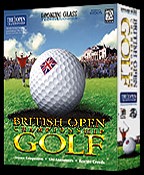
British Open Championship Golf is a 1997 sports video game developed and published by LookingGlass Technologies. A simulation of The Open Championship, it allows the player to engage in multiple forms of golf, including stroke play and fourball. The player competes at reproductions of the Royal Troon Golf Club and the Old Course at St. Andrews as and against famous golfers of the time. Announcer commentary is provided by actor Michael Bradshaw and Wide World of Sports host Jim McKay.

Super Monkey Ball Deluxe is a platform video game developed and published by Sega. It was released for the PlayStation 2 and Xbox in 2005. The game compiles all stages from Super Monkey Ball and Super Monkey Ball 2, as well as adding original levels.

Super Monaco GP is a Formula One racing simulation video game released by Sega, originally as a Sega X Board arcade game in 1989, followed by ports for multiple video game consoles and home computers in the early 1990s. It is the sequel to the 1979 arcade game Monaco GP. The arcade game consists of one race, the Monaco Grand Prix, but later ports added more courses and game modes based on the 1989 Formula One World Championship.

Tommy Lasorda Baseball is a 1989 baseball video game developed and published by Sega as one of the six launch titles for the Sega Genesis in the North America and for the Sega Mega-Tech arcade system. It is a follow-up to the arcade game Super League (1987). It prominently features former MLB player Tommy Lasorda, who was manager of the Los Angeles Dodgers at the time. In the game, players compete with either AI-controlled opponents or against other players across single exhibitions, open matches or a 30-game season.

The Lucky Dime Caper Starring Donald Duck, released in Japan as Donald Duck no Lucky Dime, is a platform game released by Sega for the Game Gear and Master System in 1991. It features Donald Duck as the main character. Another game featuring Donald Duck for the Game Gear and Master System, Deep Duck Trouble, was released in 1993.

Arnold Palmer Tournament Golf is a golf video game for the Sega Mega Drive/Genesis.
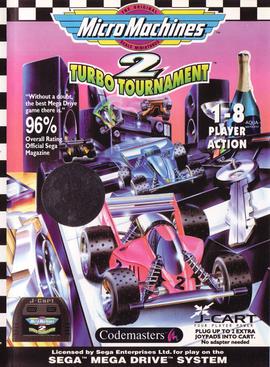
Micro Machines 2: Turbo Tournament is a 1994 racing video game developed by Supersonic Software and published by Codemasters for the Sega Mega Drive. The sequel to Micro Machines, the game is themed around Galoob's Micro Machines toys, and players race around environments in miniature toy vehicles. Micro Machines 2: Turbo Tournament adds new vehicles and game modes, and the Mega Drive version was released on J-Cart, enabling up to eight players without a multitap.
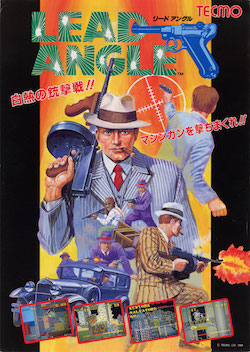
Dead Angle, also known as Lead Angle and Gang Hunter, is a 1988 arcade shooter game developed by Seibu Kaihatsu. It is the follow-up to the company's mobster-themed Empire City: 1931. In Dead Angle, players take control of the game's protagonist, who must rescue his girlfriend from a mob boss. A port of the game was released by Sega for its Master System console.
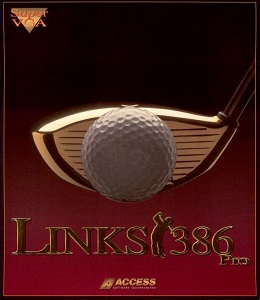
Links 386 Pro is a golf simulation sports game for MS-DOS released in 1992. It is part of the Links series, and was developed by Access Software as the follow-up to Links: The Challenge of Golf (1990). A Macintosh version, Links Pro, was released in 1994. An enhanced version called Links 386 CD was released for PC in 1995 that included audio comments by comedian Bobcat Goldthwait acting as the player's caddie, and an aerial flyby of each hole streamed from the game's CD-ROM. Re-branded versions of the game were also released for Microsoft Windows under the titles Microsoft Golf 2.0 (1994) and Microsoft Golf 3.0 (1996), part of the Microsoft Golf series.
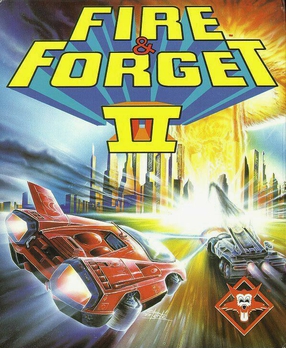
Fire & Forget II is a 1990 futuristic racing-shooter video game developed by Titus Arcade and published by Sega for the Master System, and by Amstrad for the GX4000. It is the sequel to Fire and Forget, which was developed by Titus France SA for a number of platforms including the ZX Spectrum. Fire & Forget II is one of a number of similar games which emerged in the late 1980s and early 1990s in the wake of Sega's popular arcade driving game Out Run (1986). It is notable for the variety of its enemy sprites, and for its use of parallax scrolling. It is also notable for being one of the first video games to be launched simultaneously on two consoles.
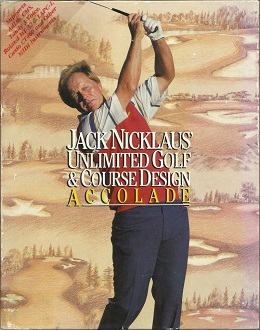
Jack Nicklaus' Unlimited Golf & Course Design is a 1990 golf video game developed by Sculptured Software and published by Accolade for the Amiga and MS-DOS. A Super NES version with the same golf courses, titled Jack Nicklaus Golf, was released in May 1992. It is the second in a series of golf games named after golfer Jack Nicklaus, following Jack Nicklaus' Greatest 18 Holes of Major Championship Golf (1988).

Jack Nicklaus Golf & Course Design: Signature Edition is a 1992 golf video game developed by Sculptured Software and published by Accolade for MS-DOS. It is part of a series of games named after golfer Jack Nicklaus, and follows Jack Nicklaus' Unlimited Golf & Course Design (1990). Like its predecessor, the game includes a golf course designer that allows the player to create customized courses. Two add-on disks provide additional courses. In 1995, both disks were re-released along with Signature Edition as a compilation titled Jack Nicklaus: The Tour Collection.



















